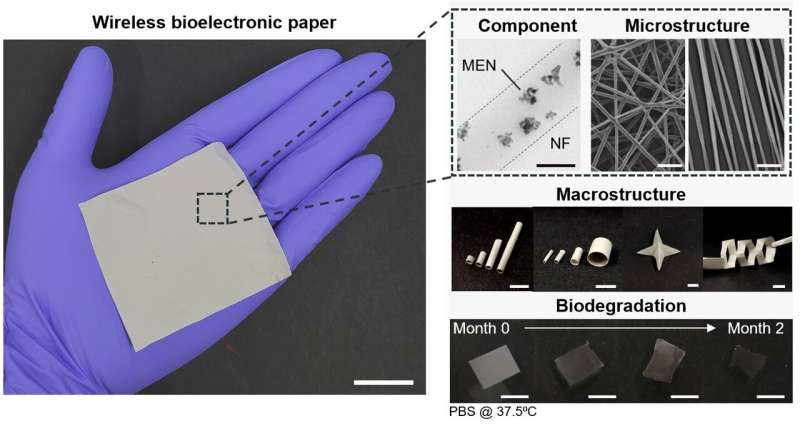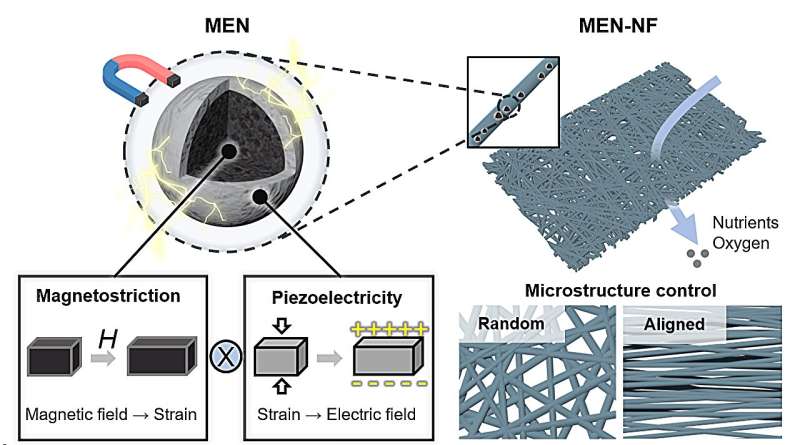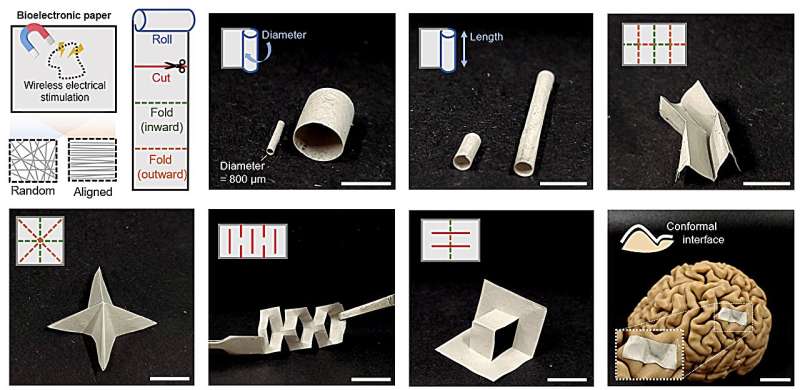This article has been reviewed according to Science X's editorial process and policies. Editors have highlighted the following attributes while ensuring the content's credibility:
fact-checked
peer-reviewed publication
trusted source
proofread
Flexible, biodegradable and wireless magnetoelectric paper for simple in situ personalization of bioelectric implants

A research team, jointly led by Professors Jiyun Kim, Chaenyung Cha, and Myoung Hoon Song from the Department of Materials Science and Engineering at UNIST, has unveiled the world's first flexible, biodegradable bioelectronic paper with homogeneously distributed wireless stimulation functionality for simple personalization of bioelectronic implants.
These innovative materials are made from nanoscale functional materials, and thus can be further customized using simple methods, such as rolling, cutting, inward folding, and outward folding without losing functionality.
The research team expects that these results with unprecedented design flexibility can lay a foundation for the low-cost, simple, and rapid personalization of temporary bioelectronic implants for minimally invasive wireless stimulation therapies.
The work is published in the journal Advanced Materials.
Implanted electrical stimulation devices are crucial for promoting neuronal activity and tissue regeneration through electrical stimulation. Therefore, these devices are essential for treating various neurodegenerative diseases, such as Parkinson's disease and Alzheimer's disease.
However, most of the state-of-the-art bioelectronic implants require rigid and bulky electronics that are mechanically incompatible with the delicate structure of nerves and other tissues, making it difficult to freely change into various sizes and shapes in real time.
In addition, the need for wire connections, battery replacement, and post-treatment removal surgeries can raise the risk of infection and make clinical treatments complex.
In this study, the research team successfully developed a flexible, biomimetic, lightweight, and biodegradable bioelectronic paper that can be cut and tailored post-fabrication while retaining functionalities, allowing for simple and rapid production of bioelectronic implants of various sizes, shapes, and micro- and macro-structures.

First, they synthesized magnetoelectric nanoparticles (MENs) that facilitate electrical stimulation in response to an external magnetic field. The synthesized nanoparticles take the form of a "Core@Shell" structure that couples a magnetostrictive core that transduces magnetic field into local strain and a piezoelectric shell that transduces strain into electric field.
By integrating MENs into electrospun biodegradable nanofibers (NFs), the team produced a paper-like, biodegradable, porous, wireless electrostimulator. In vitro experiments further demonstrated the material's ability to provide wireless electrostimulation and promote neuronal activity simultaneously.
"The developed material offers personalized treatment options tailored to individual needs and physical characteristics, simplifying treatment processes, enhancing flexibility, and versatility in electrical stimulation-based clinical applications," says Postdoctoral Researcher and First Author Jun Kyu Choe.
The fabricated material is as flexible and lightweight as paper. It can be closely attached along complex surfaces, like the curved surface of human brain models. Notably, it also can be cut into arbitrary shapes and scales, while retaining its function.
In addition, it showed exceptional flexibility enough to manufacture a cylindrical nerve conduit to regenerate nerves, with a demonstrated bending radius of 400 µm.

According to the research team, "This work presents a promising strategy for the development of flexible and biodegradable wireless bioelectronic implants that can be simply customized for various clinical and physical circumstances.
"The combination of nanoscale magnetoelectric and biodegradable fibrous materials offers advantages over traditional system-level wireless electronic devices that rely on intricate assembly of bulky components that cannot be redesigned post-fabrication."
Professor Kim stated, "The bioelectronic paper, in principle, can be simply customized to organ-scales of several tens of centimeters or miniaturized to sub-micrometer scales for minimally invasive operations, as the magnetoelectricity or microstructure does not depend on its scale.
"Overall, our bioelectronic paper with facile and broad applicability, could open up a new scheme toward minimally invasive and biodegradable wireless bioelectronic implants."
More information: Jun Kyu Choe et al, Flexible, Biodegradable, and Wireless Magnetoelectric Paper for Simple In Situ Personalization of Bioelectric Implants, Advanced Materials (2024). DOI: 10.1002/adma.202311154
Journal information: Advanced Materials


















